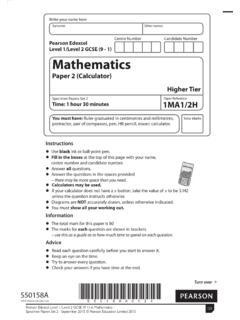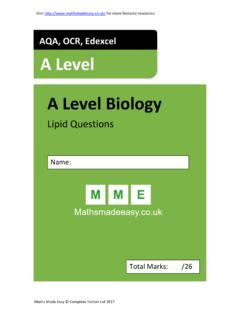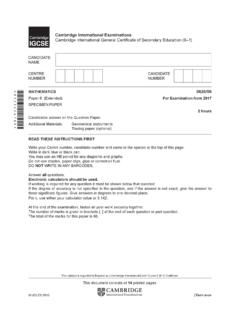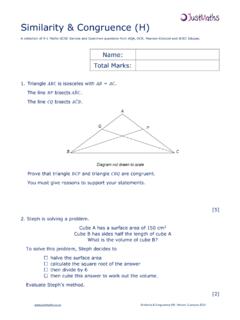Transcription of AQA, OCR, Edexcel A Level A Level Biology
1 Visit for more fantastic resources. Maths Made Easy Complete Tuition Ltd 2017 Level AQA, OCR, Edexcel A Level Biology Nucleic Acids and DNA Replication Answers Name: Total Marks: /25 Visit for more fantastic resources. Maths Made Easy Complete Tuition Ltd 2017 Proteins 1. Proteins are often described as the building blocks of life. In humans proteins can be found in every cell in the body. a. Amino acids are the monomers that make up proteins. i) Using Figure 1 below, label the amino group and the hydroxyl group (2 marks) Figure 1 ii) Describe the significance of the R group? (2 marks) b. Amino acid monomers can be joined together via condensation reactions to form a polypeptide chain. i) In Figure 2 below, identify the atoms that are removed in a condensation reaction and show what happens to these atoms.
2 (3 marks) Figure 2 ii) What is the name of the bond formed in a condensation reaction between two amino acids? (1 mark) iii) Draw the subsequent dipeptide that would be formed after a condensation reaction has occurred. (2 marks) Visit for more fantastic resources. Maths Made Easy Complete Tuition Ltd 2017 iv) What is a hydrolysis reaction? (1 mark) 2. Proteins are large, complex compounds which carry out many different essential processes in the body, from structural roles in hair cells, to digestion through enzyme action to immune protection with antibodies. a) The structure of proteins is very important. i) Describe the primary structure of a protein. (2 marks) ii) What two forms can secondary protein structure take?
3 (2 marks) iii) What chemical bonds are involved in tertiary protein structure? (3 marks) iv) Describe quaternary protein structure. (2 marks) v) Identify one globular and one fibrous protein. (2 marks) 3. A dipstick urine test is routinely performed as part of a urinalysis testing for the presence of proteins such as albumin. If albumin is present in a urine sample it indicates that there could be a problem with the kidneys. i) What is the scientific name of this test for proteins? (1 mark) ii) Describe how the test for proteins works and the results you would expect for a urine sample containing albumin?(3 marks)
















